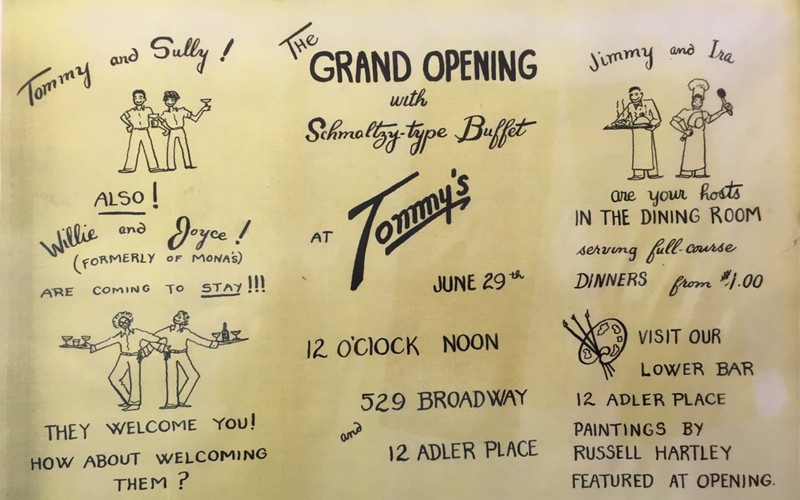Tommy's Place/12 Adler Place
Introduction
Text-to-speech Audio
Images

Backstory and Context
Text-to-speech Audio
Though many queer bars and nightclubs catered to both gay men and lesbians, In the 40s and 50s, the North Beach neighborhood developed into what could be considered a lesbian district, with several bars that catered primarily to lesbian clientele. The early 50s saw increasing lesbian and gay ownership of queer bars and cafes. The semi-public visibility that lesbians achieved in these spaces, against the backdrop of and in conflict with a dominant political ideology in the 40s and 50s that trended further and further towards conservativism, solidified lesbians as a collective, social group that mounted collective resistance. Tommy’s Place and 12 Adler Place (which for all intents of purposes was one establishment) became a site of open conflict in this dynamic.
The years following World War II/the early years of the Cold War saw a sharp decrease in forms of organized activism, as post-war anxiety and the morality crusades of Senator Joseph McCarthy took hold. Against this backdrop, homosexuality and gay culture became “contested sites for the expression of domestic policy” (Boyd 72). Homosexuality became one of many perceived symbols of general decay and subversion. “The regulation and control of female sexuality,” according to Nan Alamilla Boyd, “became an important aspect of ‘social containment’ in cold war America, and lesbians and prostitutes suffered new levels of stigma and social control” (Boyd 84). Yet, at the same time, queer nightclubs and the lesbian bars in North Beach continued to be a key part of San Francisco tourism, and were intertwined with prostitution and sex tourism. Indeed, Tommy’s owner Tommy Vasu opened her establishments with capital from the sex trade.
The San Francisco Police Department, as well as Military Police, increasingly began to take on policing sex and sexuality in this environment. Tommy’s Place, like so many other establishments, was placed on the military’s off-limits list, in 1953. Police began an investigation surrounding several high school girls, after their parents complained of them wearing men’s clothing and going to a gay bar and doing drugs. This led police to the home of a Black man named Jesse Winston, with whom the girls apparently spent time, and eventually to Tommy’s. When police raided the establishment on September 8, 1954, with warrants for the two women bartenders on the liquor license (Grace Miller and Joyce Van de Veer), they found a heroin kit in the bathroom. Many who were involved believe this to be a police plant.
A long legal battle ensured, and sensationalist headlines abounded in mainstream publications like the San Francisco Chronicle and the Examiner. The head of the SFPD’s Juvenile Bureau later would admit that the press exaggerated and exploited in their the equivalency with which many viewed homosexuality, prostitution, juvenile delinquency, and drug abuse, placing LGBT people as scapegoats.
The trial and the public outcry it engendered led to changes in policing and increased raids against queer bars and nightclubs in the coming years. Soon after, a San Francisco County Grand Jury investigation and U.S. Senate subcommittee hearing on juvenile delinquency took place in the city. The ensuing years brought more violence against the LGBT community, but also forged a collective identity and increased politicization that would boil over in the mid- to late-1960s.
Sources
Bérubé, Allan. Coming Out Under Fire : The History of Gay Men and Women in World War Two. University of North Carolina Press, 2010.
Boyd, Nan Alamilla. Wide-Open Town: A History of Queer San Francisco to 1965. University of California Press, 2003.
Flanagan, Michael. The Raid on Tommy's Place - a case of Cold War anti-queer crackdowns, Bay Area Reporter. May 16th 2019. Accessed November 1st 2020. https://www.ebar.com/bartab/barchive//276184.
San Francisco Planning Department Historic Context Statement for Lesbian, Gay, Bisexual, Transgender, and Queer History in San Francisco https://commissions.sfplanning.org/hpcpackets/2014.0266U.pdf
https://www.sfmoma.org/essay/wide-open-publics-tracing-grace-mccann-morleys-san-francisco/
